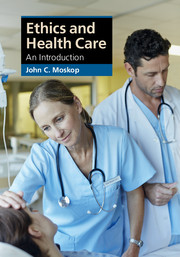Book contents
- Frontmatter
- Dedication
- Contents
- Preface
- Acknowledgment
- Part I Ethics in health care: role, history, and methods
- Part II Moral foundations of the therapeutic relationship
- Part III Controversies in health care ethics: treatment choices at the beginning and at the end of life
- Part IV Ethics in special contexts: biomedical research, genetics, and organ transplantation
- 19 Research on human subjects
- 20 The genetic revolution
- 21 Organ transplantation
- Further reading
- References
- Index
- References
20 - The genetic revolution
from Part IV - Ethics in special contexts: biomedical research, genetics, and organ transplantation
Published online by Cambridge University Press: 05 February 2016
- Frontmatter
- Dedication
- Contents
- Preface
- Acknowledgment
- Part I Ethics in health care: role, history, and methods
- Part II Moral foundations of the therapeutic relationship
- Part III Controversies in health care ethics: treatment choices at the beginning and at the end of life
- Part IV Ethics in special contexts: biomedical research, genetics, and organ transplantation
- 19 Research on human subjects
- 20 The genetic revolution
- 21 Organ transplantation
- Further reading
- References
- Index
- References
Summary
Case example
Twenty-three-year-old Ms. Alice Kemper seeks treatment in the ED of University Hospital for abdominal pain and bloating that has gotten progressively worse over the past week. Ms. Kemper reports that she had abnormal liver function tests during an uncomplicated pregnancy one year previously and that several members of her family have had cirrhosis or hepatitis. This information, along with her physical examination and the results of initial blood tests and urinalysis, suggests severe liver disease, and she is admitted to the hospital for further diagnostic testing. Based on a liver biopsy, eye examination, and genetic testing, Ms. Kemper is diagnosed with an advanced case of Wilson disease, a rare inherited disease in which excess copper accumulates in the liver, brain, eyes, and other organs. Because her liver damage is severe, Ms. Kemper is evaluated for a liver transplant. She meets the criteria for transplantation and is placed on the hospital transplant program's waiting list for a liver transplant.
While Ms. Kemper is waiting for a transplant liver to become available, she is referred to Mr. Quinn, a genetic counselor, to give her more information about her condition. Mr. Quinn explains to her that Wilson disease is caused by multiple mutations in a gene that enables production of a protein that transports copper within the body. Without this protein, excess copper accumulates in and damages multiple organs. Because Wilson disease is an autosomal recessive disorder, patients with this condition have inherited gene mutations from both of their parents. If both parents are carriers of this gene, each of their children has a one-in-four chance of inheriting the mutations from both parents and developing the disease. Mr. Quinn explains that Ms. Kemper's siblings are also at risk for this life-threatening genetic disease. Ms. Kemper informs him that she has two younger siblings, a 16-year-old brother and a 14-year-old sister, but that she does not want to inform them about her condition or communicate with them in any way. She explains that she was abandoned by her parents and her family years ago, and she refuses to have anything to do with them. She does, however, ask whether her 1-year-old daughter can be tested for the genetic markers for Wilson disease, so that she can be on the lookout for signs of the disease.
- Type
- Chapter
- Information
- Ethics and Health CareAn Introduction, pp. 285 - 306Publisher: Cambridge University PressPrint publication year: 2016

